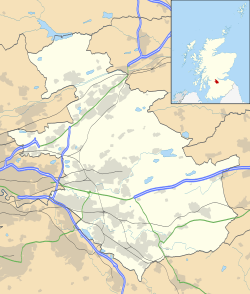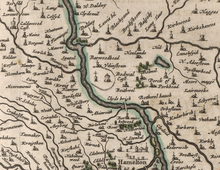Bellshill
Bellshill (pronounced "Bells hill") is a town in North Lanarkshire (which includes the village of Orbiston) in Scotland, 10 miles (16 km) south east of Glasgow city centre and 37 miles (60 km) west of Edinburgh. Other nearby towns are Motherwell (2 miles (3 km)), Hamilton (3 miles (5 km)) and Coatbridge (3 miles (5 km)). Since 1996, it has been in the Greater Glasgow metropolitan area. The town has a population of about 20,650.[2][3]
| Bellshill | |
|---|---|
 St. Andrew's Church, Bellshill | |
 Bellshill Location within North Lanarkshire | |
| Population | 20,650 Estimated mid-2012 |
| • Edinburgh | 33 mi (53 km) ENE |
| • London | 341 mi (549 km) SSE |
| Council area | |
| Lieutenancy area | |
| Country | Scotland |
| Sovereign state | United Kingdom |
| Post town | BELLSHILL |
| Postcode district | ML4 |
| Dialling code | 01698 |
| Police | Scotland |
| Fire | Scottish |
| Ambulance | Scottish |
| UK Parliament | |
| Scottish Parliament | |
History

The earliest record of Bellshill's name is handwritten on a map by Timothy Pont dated 1596 although the letters are difficult to distinguish.[4] It's possible it reads Belſsill with the first s being an old-fashioned long s. The site is recorded as being east of "Vdinſtoun" and north of "Bothwel-hauch" (which confusingly is above "Orbeſton" on Pont's map).[5] The name can also been seen on another map, which was derived from Pont's work, made by the Dutch cartographer Joan Blaeu where the place is called "Belmil".[6] The village consisted of a row of quarry workers' houses owned by Mr. Bell, who owned a stone quarry to the south of Belmill.[7] Charles Ross' map of 1773 has "Belsihill" marked north of Crosgates and Orbiston.[8] About 1810, this new settlement took on the name Bellshill[9] and continued to grow. It absorbed nearby villages such as Nesnas, Black Moss and Sykehead.[10] Bellshill was on the road which linked Glasgow and Edinburgh.[11]
According to the first Statistical Account, in the late 1700s the parish of Bothwell, which encompasses modern Bellshill , was a centre of hand-loom weaving with 113 weavers recorded. Only 50 colliers were listed.[12] A hundred or so years later, these occupations had changed places in degree of importance to the area economy. With the introduction of new machinery in the mid 19th century, many cottage weavers lost their livelihood. Demand for coal to feed British industry meant that by the 1870s 20 deep pits were in operation in the area.[13]
The first mine to open (and the last to close in 1953) was the Thankerton mine.[14] Others followed swiftly and rapidly increased the size of the town, even attracting a steady stream of immigrants from abroad, particularly Lithuania, so much so that the town is sometimes referred to as 'Little Lithuania'.[15] The rise in the migrant Lithuanian population led to the opening of The Scottish Lithuanian Recreation and Social Club within Calder Road in the Mossend area.[16]
Iron and Steel production were also central to the development of the town.[17] J. B. Neilson, developer of the revolutionary 'hot blast' process, opened the first iron works in the area (Mossend Iron Works) in 1839.[13]
During the industrial boom there were a number of railway stations, including Mossend, Fallside and Bell Cross.[18] The settlement is now just served by Bellshill railway station.
Maternity services were provided at Bellshill Maternity Hospital until the hospital was closed in 2001.[19]

According to a report by the Halifax Building Society, in the first quarter of 2005 Bellshill was the UK's property hot spot with a 46% rise in house prices. This took the average property price to £105,698 (according to reports published April 2005).
In 2006, a new mosque was opened in the Mossend area of Bellshill becoming one of the largest mosques in Scotland.[20]
The streetscape project, a plan to regenerate and modernise the town centre, commenced Apr 2007 and was completed nearly three years later. The project, created a one way system on the main street with more space for pedestrians.
Education
Bellshill once had 6 primary schools including Belvidere Primary School.[21] This was closed, however, in early June 2010 and has now been demolished. Holy Family Primary School was founded in 1868 and moved to new buildings in 1907 to accommodate an influx of Lithuanian, Polish and Irish Catholics seeking work in the area. Other primary schools include Sacred Heart Primary, Mossend Primary, Noble Primary, St. Gerard's Primary and Lawmuir Primary. There are two fairly large secondary schools, Bellshill Academy[22] and Cardinal Newman High School.[23]
Religion
Historically a Relief Church for 1000 people was built in Bellshill in 1763.[24] Today several churches serve the town. St Andrews United Free Church of Scotland sits at Bellshill Cross whilst the Church of Scotland Parish Churches are at opposite ends of the Main Street with Bellshill Central Parish church opposite The Academy, and Bellshill West Parish Church[25] next to the Sir Matt Busby Sports Centre. The town's Roman Catholic Parish Churches are St Gerard's, Sacred Heart & Holy Family, Mossend.
Culture
There is a free public library within the Bellshill Cultural Centre. Various singers, such as Sheena Easton, and sportsmen hailed from the town.
Music
Bellshill is also known for its music, especially since the mid-1980s. Bands such as the Soup Dragons, BMX Bandits and Teenage Fanclub put Bellshill on the map as an indie rock hot-spot in Scotland. The scene - known as the Bellshill Sound or the Bellshill Beat - was celebrated by influential DJ John Peel in the Channel 4 television series Sounds Of The Suburbs. Bellshill continues to produce well respected and influential independent pop music, with members of Mogwai and De Rosa hailing from the town. Sheena Easton was also from the town, and attended Bellshill Academy.
Notable people from Bellshill
The following list refers to notable people who were born in Bellshill, although they did not necessarily reside there - the town was home to Lanarkshire's maternity hospital in the latter part of the 20th century.
- Kenny Arthur (born 1978), footballer
- Jackie Bird (born 1962), Journalist and Broadcaster
- Tom Birney (born 1956), American footballer
- Sir Matt Busby (1909–94), football player and manager
- Doug Cameron (politician), Senator for NSW
- Stuart Carswell
- William Chalmers (manager)
- Peter Cherrie
- Gregory Clark (economist)
- Thomas Clark
- Robin Cook, politician
- Tom Cowan
- James Dempsey
- Mike Denness
- Alex Dickson, boxer
- Henry Dyer
- Sheena Easton, vocalist
- Scott Fox, goalkeeper for Ross County
- Hughie Gallacher, Scottish internationalist footballer and Football League winning captain of Newcastle United
- Peter Grant
- Scott Harrison (boxer), former world boxing champion
- Lee Hollis
- Jackie Hutton
- Brian Irvine
- Brian Kerr
- Bryan Kirkwood (producer)
- Ryan Lawrie
- David Lilley
- Malky Mackay
- Chris Maguire
- Kevin McBride (footballer)
- Frank McCarthy (disc jockey)
- Brian McClair
- Ally McCoist
- Eric McCormack (writer)
- Lee McCulloch
- John McCusker
- Ethel MacDonald (anarchist)
- Chris McGroarty
- Paul McGuigan (filmmaker)
- Tom McKean
- Billy McNeill
- James McPake
- Hugh Murray (footballer)
- Alex Neil (footballer)
- David Shaw Nicholls
- Phil O'Donnell (footballer)
- Tommy O'Hara
- Sean O'Kane
- Jim Paterson (footballer), full-back/winger Plymouth Argyle
- John Rankin (footballer)
- John Reid, politician
- James Cleland Richardson
- Natalie J Robb
- Sharleen Spiteri, singer, songwriter, guitarist and lead vocalist of Texas
- Steven Smith (footballer)
- Harry Stanley
- John Stewart (footballer, born 1985)
- Kenny Wright (footballer)
Bands from Bellshill
Sport
The town has a football team, Bellshill Athletic, that plays in the Scottish Junior Football West Premier League. They play their home games at Rockburn park after moving away from Tollcross, Glasgow, after New Brandon Park was closed down to reduce costs.
Bellshill also has the Sir Matt Busby Sports Complex (Named after the late Manchester United legend who was born and brought up in the area) that opened in 1995. It has a 25m swimming pool, with two large spectator seating areas either side, a large hall and health suite. The complex also has a gym and a dance studio.
There is a golf course next to nearby Strathclyde Park. The Greenlink Cycle Path also travels through the golf course and the Orbiston area of Bellshill, heading towards Forgewood.
Location grid
References
- List of railway station names in English, Scots and Gaelic Archived 22 January 2013 at the Wayback Machine - NewsNetScotland
- "Key Facts 2016 - Demography". North Lanarkshire Council. Archived from the original on 4 January 2018. Retrieved 3 January 2018.
- "Estimated population of localities by broad age groups, mid-2012" (PDF). Retrieved 3 January 2018.
- "Glasgow and the county of Lanark - Pont 34". Maps of Scotland. Timothy Pont (16th century). Retrieved 31 December 2017.
- "Bellshill on Pont's map no. 34". National Library of Scotland. Retrieved 6 January 2018.
- Blaeu, Joan. "Glottiana Praefectura Inferior". National Library of Scotland. Retrieved 30 December 2017.
- "1986 - BELLSHILL AND MOSSEND". BBC. Retrieved 31 December 2017.
- "County Maps". National Library of Scotland. Retrieved 2 January 2018.
- "Six Inch Maps". National Library of Scotland. Retrieved 2 January 2018.
- "25 inch O.S. Map with zoom and Bing overlay". National Library of Scotland. Ordnance Survey. Retrieved 30 December 2017.
- Lewis, Samuel (1851). A topographical dictionary of Scotland, comprising the several counties, islands, cities, burgh and market towns, parishes, and principal villages, with historical and statistical descriptions: embellished with engravings of the seals and arms of the different burghs and universities. London: S. Lewis and co. p. 123. Retrieved 2 January 2018.
- Macculloch, Michael (1795). The statistical account of Scotland. Drawn up from the communications of the ministers of the different parishes (Vol 16 ed.). Glasgow: Dunlop and Wilson. p. 304. Retrieved 2 January 2018.
- Wilson, Rhona (1995). Bygone Bellshill. Catrine, Ayrshire: Stenlake Publishing. p. 3. ISBN 9781872074597.
- Wilson, Rhona (1995). Bygone Bellshill. Catrine, Ayrshire: Stenlake Publishing. p. 4. ISBN 9781872074597.
- "Lithuanians in Lanarkshire". Legacies: UK history local to you. BBC. Retrieved 6 January 2018.
- Fisher, Jack (1995). Old Bellshill in pictures. Motherwell: Motherwell Leisure. p. 47. Retrieved 30 December 2017.
- Mort, Frederick (1910). Lanarkshire. Cambridge: Cambridge University Press. p. 152. Retrieved 30 December 2017.
- Groome, Francis Hindes (1895). Ordnance gazetteer of Scotland: a survey of Scottish topography, statistical, biographical, and historical. London: W. Mackenzie. p. 140. Retrieved 31 December 2017.
- "Maternity staff reunion just the start". Motherwell Times. 28 March 2016. Archived from the original on 2 August 2019. Retrieved 2 August 2019.
- "Google Mosque Map - UK Mosques Directory". mosques.muslimsinbritain.org.
- "1986 - EDUCATION". BBC. Retrieved 31 December 2017.
- Fisher, Jack (1995). Old Bellshill in pictures. Motherwell: Motherwell Leisure. pp. 39–40. Retrieved 30 December 2017.
- "1986 - COMPREHENSIVE EDUCATION". BBC. Retrieved 31 December 2017.
- Gardiner, Matthew (1845). The new statistical account of Scotland. Edinburgh and London: W. Blackwood and Sons. p. 800. Retrieved 31 December 2017.
- "Church celebrates 140th anniversary". Motherwell Times. 11 January 2018. Retrieved 13 January 2018.
External links
| Wikimedia Commons has media related to Bellshill. |
- 2001 Settlement Population - Census data
- Towns and villages in Monklands area
